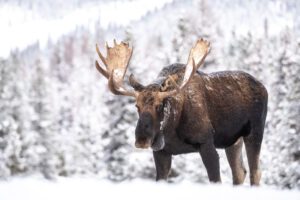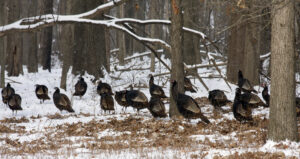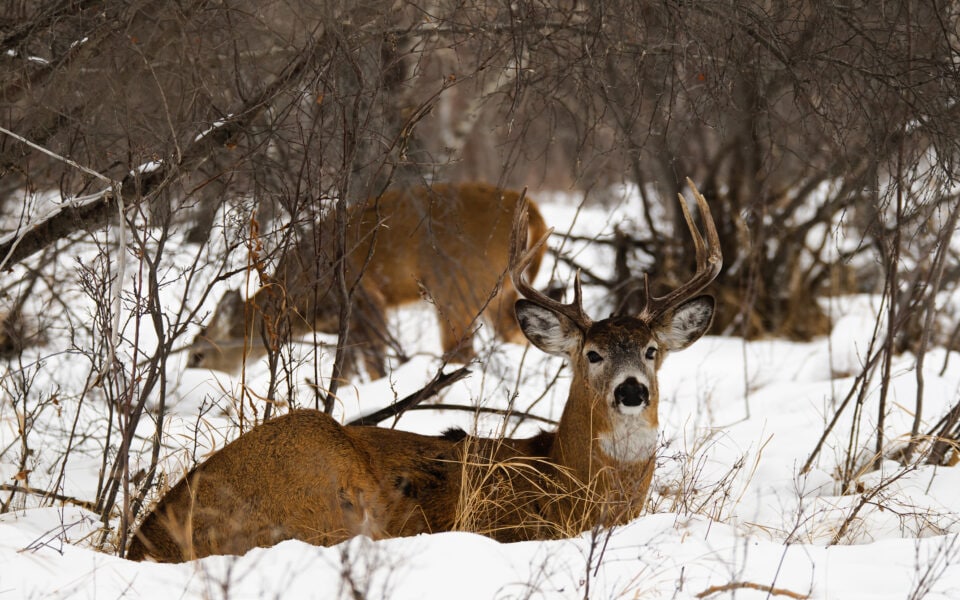Imagine temperatures below zero for sustained periods, snow several feet deep – all causing a lack of food and “housing” – it’s a reality for many animals. It fascinates me to see all the different adaptions various species have made to cope with winter’s onslaught – especially those in northern states and Canada.
It depends upon whether we’re talking about mammals, birds or reptiles, but different species have unique ways of surviving this icy, cold, snow-covered period. Whether it’s migration, hibernation, brumation (metabolism slows considerably), or torpor (body temperature decrease), animals of all kinds have adapted ways of enduring winter. Some, like frogs, even create proteins to make a sort of “antifreeze” that prevents them from turning into “frog-cycles.” Some birds and fish just keep moving to stay alive. You could also add “seasonal color molting” to the list as this survival mechanism helps some prey species hide from predators and certain predators to keep a lower profile. Let’s look at some of our favorites and a few that have adapted unusual methods to endure Jack Frost.
Hoofed Mammals Winter Survival
 Whitetails & Mule Deer
Whitetails & Mule Deer
We may as well begin with the reason why many of you read GameKeepers … deer. These fun to hunt and good to eat animals are a passion in my life – they are fascinating and beautiful. Their physiology maintains their body heat at 104° F throughout the year. While their summer coat provides protection from the sun and helps keep the animal cool, their winter coat insulates them. The hollow guard hairs provide protection and insulation, but it’s really the finer, wool-like hair underneath that affords the greatest insulation value. The outer guard hairs trap air and create their own water-repellent to keep the hairs underneath dry. This is why you may have seen snow build up on a deer’s back without melting. With a body temperature of 104°, the only way that’s possible is because of their coat’s excellent insulation and water-repelling qualities.
Their ability to store fat is another common attribute in all deer species. Fat is essentially “concentrated energy” and it can provide much of a deer’s wintertime calories. A deer entering winter with ample fat reserves can withstand a 30% weight loss and still survive. In our northern most areas, they come directly out of breeding and straight into winter without time to recoup the fat stores burned off during the rut. This is why a higher percentage of mature bucks die during harsh winters.
There’s been a debate in recent years about whether a deer’s metabolic rate slows down during the winter. The argument is really about the precise meaning of “metabolism.” There is no doubt that during the winter they are much less active and consume less food. Deer have adapted specific physiological and behavioral changes to survive winter’s wrath. In the wake of a snow storm I have watched a small herd of whitetails bed down for almost three days straight without getting up to feed – despite the fact that there were ample food plot crops within 200 yards and a corn feeder within 50 yards of their bedded location. I believe in this case; their instincts probably tell them they are likely to burn off more energy than they intake so they remain inactive.
Both, whitetails and mule deer will also begin to group-up during winter, they may travel to a south-facing slope or go many miles to a “deeryard.” In the case of mule deer, it is often referred to as a “winter range.” These places will almost assuredly have thermal cover, good browse sources and protection from the elements. Even mature bucks that spend a good part of the year in solitude or with a bachelor group seem to live in close proximity to the other deer during the winter. If the travel to these places is long enough, it would then be called a “migration.” Mule deer in Wyoming have been known to travel over 150 miles, over highways, across rivers and reservoirs, and over, under or around hundreds of fences to their winter range.
Pronghorn

While deer may migrate to a spot and stay, “speed goats” may not stop moving until they find survivable conditions. It really depends upon the circumstances – they tend to go as far as they need to out-distance the deep snow. Pronghorn have a much more difficult time with fences and highways than deer species do, but if they find a hole in the fence, they’ll keep moving. In some cases, in states like WY and CO they will travel over 100 miles to find suitable conditions. Archeological evidence in Grand Teton National Park suggests that the same annual migration has been repeated for almost 6,000 years.
Elk & Moose
 Elk and moose have long enough legs to traverse deeper snow. Both also have larger bodies than deer and pronghorn so they can store more fat. When the fat reserves run low, elk graze on grass and woody plants. They’ll also eat agricultural crops, and in areas that have ranches, they may relentlessly attack the livestock’s hay reserves. In fact, adult bulls can be aggressive toward livestock. In areas where private property damage like this occurs, often feeding sites are established to help minimize the rancher’s losses.
Elk and moose have long enough legs to traverse deeper snow. Both also have larger bodies than deer and pronghorn so they can store more fat. When the fat reserves run low, elk graze on grass and woody plants. They’ll also eat agricultural crops, and in areas that have ranches, they may relentlessly attack the livestock’s hay reserves. In fact, adult bulls can be aggressive toward livestock. In areas where private property damage like this occurs, often feeding sites are established to help minimize the rancher’s losses.
With moose, winter mortality is not as bad as with the other deer species. Moose do much better in cold than other deer species but don’t herd-up like the others. Deep snow doesn’t prevent them from moving or eating and they actually prefer areas that get seasonal snow cover. Their leg length is double a deer’s and an adult bull can stand 7 feet tall at the front shoulder. They can get to the willows and other woody vegetation that would be out of reach for other species.
Feathered Fowl Winter Survival

Waterfowl
We all know that waterfowl migrate. Actually, most of our bird species make this journey to the south for winter and then back north for the summer. Waterfowl are just the most visible to most of us. Why do they migrate? It’s an adaptive strategy hinged on finding suitable habitat, it’s as simple as survival – they must. Just as the photoperiod (the proportion of daylight to darkness) triggers the rut in deer, it also triggers migration in birds. Research shows an increase in intense feeding, nighttime restlessness, exercising flight muscles and more vocalizations, just prior to migration.
Grouse
Ruffed grouse and sharp-tailed grouse live in areas that can get deep snowfall. Ruffed grouse actually thrive during heavy snows and frigid temperatures and just like skiers, these species love powder. When the snow is fluffy, these birds create one of nature’s most unusual winter shelters.
Their accommodations may have more in common with the indigenous Inuit people than other birds. They will fly along and dive-bomb head-first into the deep, fluffy snow – completely immersing itself under the snow. Then, its body heat creates a sealed dome under the snow: in essence, its snow-shelter. This small “snow-cave” allows the grouse to stay warm even in the nastiest conditions. Studies show that the snow shelter can warm to 32° degrees F and rarely drops below 20° F even when it’s much colder outside.
I learned of this as a youngster in northern Minnesota one morning when on my way to a treestand in the dark. While trudging through the snow, something “exploded” at my feet and about scared the “pellets” out of me. I thought it was a bird, but it wasn’t until I went back to examine the site in the light of day and could see the wing marks in the snow that I began to understand. That, combined with the familiar sound of those speedy wing-beats and I surmised it must be a grouse. Since that day, while hunting North Dakota and Manitoba I have also seen sharp-tailed grouse do this.
Regrettably, these snow shelters are not without risks for grouse. Obviously they are closer to the “nose-level” of coyotes and other predators. Researchers have also found instances when a crust forms on the snow, trapping the grouse inside. If the crust persists, the grouse cannot escape and dies in its little “snow cave.”
Turkeys, Pheasants and Quail
 To these three species, it’s all about the habitat. Each can survive freezing temperatures well as long as they have some high-quality habitat nearby. These birds must use more energy to stay warm under winter conditions so they need to increase their food consumption. The snow depth and harsh winds are more detrimental than the cold temperatures. If their food is buried, it takes all their energy to procure more food rather than it being available to use it for warmth.
To these three species, it’s all about the habitat. Each can survive freezing temperatures well as long as they have some high-quality habitat nearby. These birds must use more energy to stay warm under winter conditions so they need to increase their food consumption. The snow depth and harsh winds are more detrimental than the cold temperatures. If their food is buried, it takes all their energy to procure more food rather than it being available to use it for warmth.
Thick cover along fields provides many benefits for quail and pheasants, and turkeys, also, when found in the same areas. Aside from protecting them from inclement weather, this thick cover can provide thermal protection. Even a few degrees can have a tremendous impact on survival. Researchers from Quail Forever found that the temperature inside a high-quality shelterbelt can be 5° F warmer than outside of it. Those 5 degrees can be the difference between life and death.
Other Mammals Winter Survival
Bears
Bats, skunks, ground squirrels and bears all hibernate. Being a Minnesota boy, I grew up with black bears around…but not all the time. They would disappear from the landscape during the winter. As a youngster, this mesmerized me. Why and how could an animal do this? Basically, they take a long nap and recycle their pee. While the process is obviously more complex than that, the result is a highly efficient system that has developed to permit bears to hibernate for months, yet still retain most of their muscle mass.
 Professor emeritus at the University of Wyoming, Hank Harlow, spent a large part of his storied career researching bears. He would track them to their dens, measure body fat and muscle mass, first in the summer, then early during hibernation, and again five months later. He, and other researchers found is that bears don’t pee while they sleep. They also don’t lose much muscle mass or strength.
Professor emeritus at the University of Wyoming, Hank Harlow, spent a large part of his storied career researching bears. He would track them to their dens, measure body fat and muscle mass, first in the summer, then early during hibernation, and again five months later. He, and other researchers found is that bears don’t pee while they sleep. They also don’t lose much muscle mass or strength.
In five months of inactivity, a bear loses an average of about 25 percent of its strength. In three or four months of not moving, humans would lose about 60 percent. Bears do this by recycling their urea. When you get up in the morning and pee, you expel a lot of nitrogen. Bears recycle it into their blood, then their guts and then to the liver. The liver is where they make amino acids, and then the skeletal muscle is resynthesized.
This system also helps them heal. Harlow spent years working with a professor of surgery at the University of Minnesota, Paul Iaizzo, documenting how bears recover from wounds during hibernation. Bears with small incisions before hibernation healed completely with limited scarring by the end. “Even significant injuries incurred prior to hibernation, but which had not begun to heal by the time of hibernation, were completely resolved in 1 to 2 months.” Iaizzo wrote on his University of Minnesota website. “This unique healing ability is a clear survival advantage for bears, as those unable to heal while hibernating could suffer loss of body fluids, greatly increased metabolic demands, and/or toxicity from infection.”
I assume this is why some traditional Asian medicines use bear gallbladders. Fever, liver disease, convulsions, diabetes and heart disease are some of the conditions treated with these medications. While there is scientific evidence that supports this, equally effective synthetic substances are available.
Prairie Dogs
If you own livestock in western states or have ever hunted Merriam’s turkeys, you may know the nemesis of prairie dogs. They eat forage that could otherwise be available for other animals, but you can’t begrudge them that, they also want to survive. However, I can blame them for numerous broken cattle, horse and deer legs from the holes and tunnels they dig – and goofing up several turkey hunts for me because of their silly little alarm bark.
The black-tailed prairie dog can hibernate on demand – they choose when. But not all prairie dog species have this ability. White-tailed prairie dogs, which are found further west, are habitual hibernators. They vanish underground in the fall and don’t come back up until spring. They go into what is called a “deep hibernation,” waking up every 15 to 20 days to stretch and urinate, then go back to sleep. Black-tailed prairie dogs can do this, but they don’t seem to go into deep hibernation unless there is a lack of food or very cold temperatures.
Throughout most of our country and Canada, the winter months and the peak of summer are the two toughest times for wildlife survival. During both periods, scarcity of food is usually the reason for this, but during winter they have the added punch of cold temperatures, harsh winds and the need for more energy for warmth. While some of the species covered are not ones we normally manage private properties for, there are some general practices we can do, often highlighted in this magazine, that will help most wildlife species through the hardest winters.
Join our weekly newsletter or subscribe to GameKeepers Magazine.
Your source for information, equipment, know-how, deals and discounts to help you get the most from every hard-earned moment in the field.


 Whitetails & Mule Deer
Whitetails & Mule Deer



